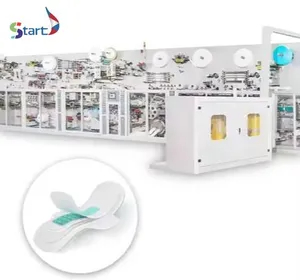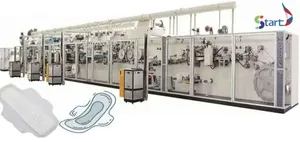Revolutionizing Hygiene Manufacturing: The Future of Sanitary Napkin Production
INDUSTRIAL SUPPLIES
12/4/20236 min read


The Need for Advanced Sanitary Napkin Production
In today’s modern world, hygiene products like sanitary napkins are indispensable, offering essential comfort, protection, and health benefits to millions of women globally. With increasing demand and growing awareness surrounding menstrual health, the sanitary napkin industry is booming. The challenge, however, lies in meeting this demand while maintaining product quality, consistency, and cost-efficiency. This is where advanced sanitary napkin production machines come into play.
These state-of-the-art machines are engineered to streamline manufacturing, improve product quality, and boost production efficiency. They play a crucial role in ensuring that sanitary napkins are produced to the highest standards while meeting the expectations of modern consumers. In this article, we’ll explore the various types of sanitary napkin production machines, their features, benefits, and the future of manufacturing in this essential industry.
The Evolution of Sanitary Napkin Production Technology
1. The Early Days of Sanitary Napkin Manufacturing
Historically, the production of sanitary napkins was a labor-intensive process, largely carried out by hand. It wasn’t until the 20th century that technology began to influence the manufacturing process. Early machines were designed to automate some aspects of production, such as cutting and shaping pads, but the process remained relatively simple.
However, with the growing demand for disposable sanitary products and a push for higher standards of quality, sanitary napkin production machines underwent significant transformations. Today, automated and highly sophisticated machinery dominates the market, enabling manufacturers to produce high volumes of sanitary napkins quickly, efficiently, and consistently.
2. The Introduction of Advanced Technology
Modern sanitary napkin production lines are now equipped with features that were once unimaginable. These machines use advanced automation, quality control systems, and smart technologies to produce sanitary napkins at unprecedented speeds while ensuring high-quality standards. Manufacturers today rely on automatic production lines that handle everything from raw material input to finished product output.
These innovations not only improve production efficiency but also minimize waste, reduce human error, and lower labor costs, making sanitary napkin production more sustainable and profitable.
Types of Sanitary Napkin Production Machines
There is a wide range of sanitary napkin production machines available in the market today, each tailored to meet specific needs and requirements. Below are some of the most advanced and widely used types of machines in the industry:
1. Advanced Automatic Sanitary Napkin Production Line for Women
The advanced automatic sanitary napkin production line for women is one of the most innovative machines in the market. Designed to handle large-scale production, this machine automates the entire process of sanitary napkin manufacturing, from raw material input to the packaging of finished products.
With the ability to produce various sizes and types of sanitary napkins, this production line offers flexibility, ensuring that manufacturers can meet diverse consumer demands. The machine is equipped with high-speed automation, reducing production time and ensuring consistency across all units. Additionally, it comes with integrated quality control systems that ensure each sanitary napkin meets safety and hygiene standards.
2. Automatic Sanitary Napkin Production Machine
The automatic sanitary napkin production machine is another key piece of technology driving innovation in the hygiene products industry. This machine is designed to manufacture sanitary napkins with minimal human intervention. It features fully automated processes such as forming, cutting, absorption core insertion, and folding, ensuring each sanitary napkin is perfectly shaped and securely sealed.
One of the standout features of this machine is its versatility. It can produce different types of napkins, such as ultra-thin, regular, and night use sanitary napkins, with minimal setup changes. The machine also includes an automatic packing system that enhances the speed of packaging, allowing manufacturers to keep up with high demand.
3. Advanced Automatic Sanitary Pad Production Machine for Efficient Manufacturing
The advanced automatic sanitary pad production machine takes efficiency to the next level. It’s designed for high-speed production with a focus on minimizing material waste and energy consumption. This machine uses advanced technologies like suction systems and servo motors to ensure high precision and reliability.
Unlike traditional methods, which often waste materials and require frequent stops for maintenance, this machine maximizes output while maintaining top-quality standards. The advanced automatic sanitary pad production machine is perfect for manufacturers looking to scale their production capacity without compromising product quality.
How Sanitary Napkin Production Machines Work
Understanding the operational mechanics behind sanitary napkin production machines can provide insight into how these machines have revolutionized the manufacturing process. The production of sanitary napkins involves several critical stages, each of which is automated by modern machinery:
1. Raw Material Preparation
The process begins with the preparation of raw materials, which typically include non-woven fabric, absorbent core materials (like SAP or fluff pulp), and back sheets (made of breathable film or cloth). The raw materials are loaded into the production machine, where they are automatically fed into the system.
2. Core Formation and Assembly
The next step is the creation of the absorbent core. Absorbent materials like super-absorbent polymer (SAP) and fluff pulp are combined and layered to form the core, which is then placed in the center of the napkin. The machine ensures that the correct amount of absorbent material is used to prevent leaks and maximize absorption.
3. Shaping and Cutting
Once the core is placed, the machine moves to the shaping stage, where the napkin is cut to the desired size and shape. This stage is crucial for ensuring the napkin fits perfectly and is comfortable for the user. The cutting process is highly precise, allowing manufacturers to create napkins in various sizes, from panty liners to overnight pads.
4. Wrapping and Packaging
Finally, the sanitary napkins are wrapped and packed for distribution. Many sanitary napkin production machines now feature automatic packaging systems, where finished napkins are neatly stacked and placed in individual packages. This automated packaging minimizes handling and ensures the napkins remain hygienic and sealed until use.
Benefits of Using Advanced Sanitary Napkin Production Machines
1. Increased Efficiency and Speed
One of the main advantages of using advanced sanitary napkin production lines is the significant improvement in manufacturing speed and efficiency. These machines can produce thousands of sanitary napkins per hour, drastically reducing production time. As demand for sanitary products increases, manufacturers can meet these demands without sacrificing quality.
2. Consistency and Quality Control
Automated machines offer high levels of precision and consistency, ensuring that every sanitary napkin produced is of the same quality. This consistency is vital in the hygiene industry, where even small variations in product design or performance can lead to consumer dissatisfaction.
Additionally, many sanitary napkin production machines come with built-in quality control features, such as vision inspection systems that check for defects or irregularities. These systems help detect any issues in real-time, reducing the risk of defective products reaching consumers.
3. Reduced Labor Costs
By automating the production process, manufacturers can significantly reduce labor costs. Workers no longer need to be involved in manual tasks such as cutting, folding, or packaging. This shift allows businesses to allocate labor resources more effectively and reduce overhead costs associated with manual labor.
4. Scalability and Flexibility
Advanced machines offer manufacturers the ability to scale up production to meet increasing demand. Whether the goal is to produce larger volumes or diversify the types of sanitary napkins produced, these machines offer flexibility. From ultra-thin pads to overnight heavy-duty pads, manufacturers can adjust their production to meet the changing preferences of consumers.
Challenges in the Sanitary Napkin Manufacturing Industry
Despite the many advantages of automated sanitary napkin production machines, manufacturers face several challenges that can impact production efficiency and cost-effectiveness. These include:
1. High Initial Investment
The cost of advanced production lines can be quite high, with prices ranging from $500,000 to $1,100,000 per machine. While these machines offer significant long-term savings, the initial capital investment can be a barrier for small manufacturers or startups.
2. Maintenance and Downtime
While modern machines are designed for high reliability, regular maintenance is still required to keep production running smoothly. Maintenance costs can add up over time, and unexpected downtime can result in production delays.
3. Material Sourcing
Another challenge for manufacturers is securing a consistent supply of high-quality raw materials. The choice of materials—such as non-woven fabric, absorbent cores, and back sheets—can affect the overall performance and quality of the final product. Any disruptions in the supply chain can impact the production timeline and product quality.
Conclusion: The Future of Sanitary Napkin Manufacturing
The sanitary napkin manufacturing industry is at a transformative juncture, thanks to innovations in automation and production technology. Advanced automatic production lines are revolutionizing the industry, offering greater efficiency, higher quality, and better cost-effectiveness. As the demand for high-quality, reliable sanitary products continues to grow, these machines will play a pivotal role in meeting global needs.
For manufacturers looking to stay competitive, investing in advanced sanitary napkin production machines is not just an option—it’s a necessity. As technology evolves, the future of sanitary napkin manufacturing looks promising, offering new opportunities for growth, efficiency, and innovation.


